|
|
|
|
|
Intel "Pentium D" and "840 Extreme Edition" Dual-Core CPUs |
|
Join the community - in the OCAU Forums!
|
Basic System Readings, Cooling and Power
Pentium D processors come with an enhanced version of the cooler that is used for the 500 and 600 series. The reason is obviously the increased thermal load dual core processors have to cope with.
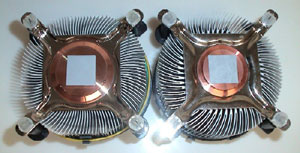 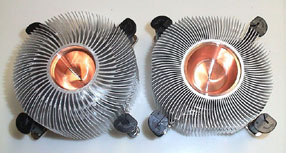
The basic design is the same, but the shape of the fins has been changed to enlarge the surface area. The copper core has been enlarged as well, and the fan blades are bigger for better CFM.

The 500 and 600 series fan comes with 0.28 Ampere Sanyo Denki fan, the Pentium D fan comes with a 0.42 Ampere NIDEC fan. When the system was idling we did not find a difference between these 2 heatsinks, but under load the Pentium D cooling device kept the processor between 1 and 2C cooler than the 500/600 series cooler.
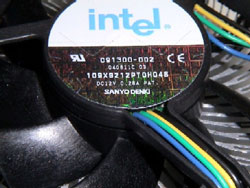 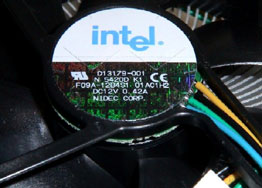
BASIC SYSTEM READINGS, TEMPERATURE AND POWER CONSUMPTION:
Bear in mind that it's not just the dual-core CPUs that are new here, but also the Intel 955X chipset and the Intel 955XBK motherboard. A lot of new and untested hardware is coming together here. Nonetheless we did not find any compatibility or stability issue. In addition the 955X chipset seems to offer ample overclocking potential as we will later show. The Pentium D package looks like any other LGA 775 processor. Package dimensions, design, and pin count are identical with a 500 or 600 single core P4. The same LGA 775 socket is used for both processor types. The only difference that is noticeable from outside are a few more capacitors on the Pentium D backside.
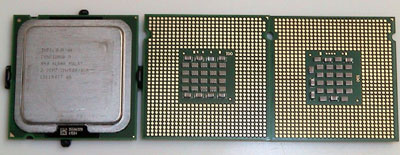
Left: 840 front - Centre: 840 back - Right: 3.73 back
All Pentium D tests samples were properly recognized, by Windows XP and system utilities such as CPU-Z, as 2 (Pentium D) or 4 core (840XE) processors. All Pentium D in our test are stepping “A0”. It's an impressive view to see Windows Task Manager showing the 840XE running on all 4 “cylinders”.
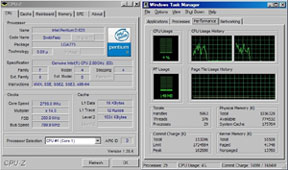 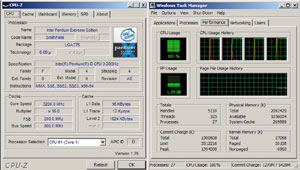
Left: 820 - Right: 840XE
It goes without saying that a dual core processor needs more power than a single core processor running at the same clock frequency. A dual core Pentium D starts with a high baseline consumption, because a single “Prescott” 1M core is already consuming a lot of power. It’s therefore no surprise that Smithfield, comprising 2 Prescott 1M cores, is setting new records in this regard. Intel has given Pentium D the same temperature reducing features that come with the recently introduced Pentium 4 600 processor series, such as Thermal Monitoring 2 (TM2), Enhanced Halt State (C1E), and most important “Enhanced Speed Step” (EIST). The 820 does not have EIST though. EIST is dropping the multiplier dynamically to 14x when the processor is idling or running with low load. The 820 is by default already running with a 14 x CPU multiplier. EIST is therefore useless for the 820. You can find a detailed description how these features work in our recent Pentium 4 600 series review. More important than the idle temperature is the CPU heat dissipation under full load. To simulate such a situation we kept 2 instances of “SuperPI” in parallel running for around 20 minutes calculating 32 million digits each.
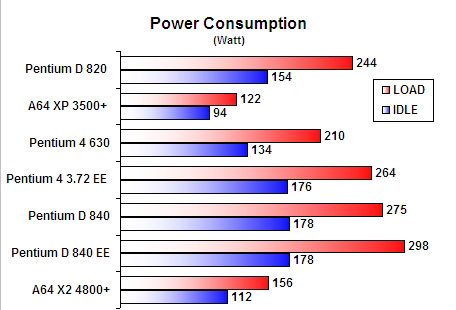
The wattage monitoring unit we used reads power consumption at the wall plug. The values shown in the “Power Consumption” chart represent therefore total system consumption and not only CPU power consumption.
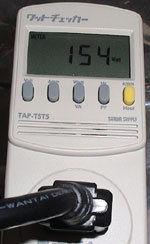
Pentium D and in particular 840XE power consumption are very high in comparison with AMD’s A64. The 90nm “Venice” core powering our test XP 3500+ needs the least power. The X2 4800+ under load consumes less power than the 840 and the 840XE when idling.
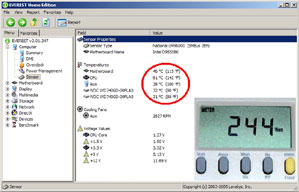 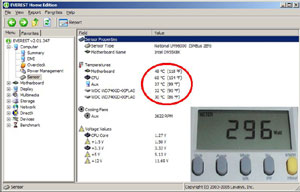
Left: 820 - Right: 840XE
Power consumption translates directly into heat dissipation. With the Pentium D stock cooler we measured a system power consumption of 244 Watt and a CPU temperature of 61C for the 820, with 298 Watt and 68C for the 840XE during our “SuperPI” stress test. When 4 instances of the “Folding@Home” client were running in parallel, the 840XE temperature reached 70C.
These temperatures are within the specified temperature range that Intel gives in the Pentium D and 840XE technical documentation. In other words, although apparently high, and certainly not desirable, Smithfield should handle 70C without a problem. Even when using more efficient 3rd party air-cooling, the user should expect to get temperatures close to 60C under full load with an 820 and above 60C with an 840XE. It seems that “Thermal Monitoring 2” is invoked much later than previously with TM1. In none of our tests did we notice thermal throttling. A well ventilated PC case is a must for stable operation of a Pentium D system. The ideal set-up for such a system would be water cooling. If power-hungry hardware is added, like a high-end video card, a power supply unit with a minimum of 450 Watt seems to be a good idea.
|
|
Advertisement:
All original content copyright James Rolfe.
All rights reserved. No reproduction allowed without written permission.
Interested in advertising on OCAU? Contact us for info.
|

|


